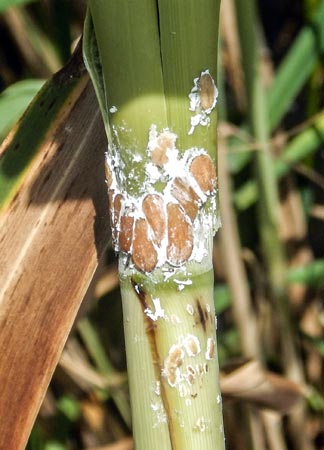Phragmites Scale Newest Coastal Threat
 The Louisiana coast is no stranger to environmental challenges, but the threat to roseau cane (Phragmites australis) is new. About a year ago, Plaquemines Parish residents started to notice something different about the usual dense, green coast: It was thinning and browning.
The Louisiana coast is no stranger to environmental challenges, but the threat to roseau cane (Phragmites australis) is new. About a year ago, Plaquemines Parish residents started to notice something different about the usual dense, green coast: It was thinning and browning.
Roseau cane is integral to protecting the marsh from erosion because of its aggressive growth and large root system. The cane, typically standing anywhere between 12 and 18 feet tall, has seen large die-offs since November 2016.
Rodrigo Diaz, Louisiana State University (LSU) professor of entomology and LSU AgCenter researcher, was alerted to the problem by the Louisiana Department of Wildlife and Fisheries (LDWF). It took several months to identify the cause: A small-scale insect that measures less than half an inch at maturity which feeds on the sap of the plant.
The scale insects attacking the cane are native to China and Japan. How they ended up in coastal Louisiana is unknown. Methods used to manage the insect in those countries include seasonal flooding and burning — two solutions not well-suited for Louisiana.
Cane samples collected by Diaz and his colleagues from last fall feature stalks covered with scales up to three layers deep. Anywhere between 10 and 100 scales can be found within 10 inches on individual samples. In a sample from August 2017, one plant from lower Plaquemines had 2,298 scales.
“Over time, the energy the plant is supposed to store within the root system is drained. At large scale densities, as seen in lower Plaquemines, the scales are stressing the plant,” Diaz said. “When you are stressed, your immune system is compromised and you become more susceptible to other things. In this case, the cane becomes more susceptible to other environmental factors or diseases.”
Four varieties of the cane are found along Louisiana’s coastline, and only one of those varieties may be considered native. Of the four, the researchers note that the European variety is faring better that the rest. While scientists observed cane regrowth in affected areas was noticeably weaker this year, the European variety looks to be more resistant to attack than others.
“From a restoration perspective, therein might lie our solution. If we can encourage the growth of this European variety, it may solve our problems. There is something about the European variety that is not affected as severely as others,” said Jim Cronin, LSU professor of biological sciences.
Both Diaz and Cronin recognize how imperative finding a solution to this problem is, and Cronin notes scientists in Europe have been dealing with the same issue for decades. “It’s a multi-faceted problem, and there isn’t really a simple solution to it. The reality is that finding a solution is just going to take more time.”
